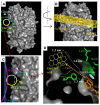Recent Advances in the Direct Electron Transfer-Enabled Enzymatic Fuel Cells
- PMID: 33644003
- PMCID: PMC7902792
- DOI: 10.3389/fchem.2020.620153
Recent Advances in the Direct Electron Transfer-Enabled Enzymatic Fuel Cells
Abstract
Direct electron transfer (DET), which requires no mediator to shuttle electrons from enzyme active site to the electrode surface, minimizes complexity caused by the mediator and can further enable miniaturization for biocompatible and implantable devices. However, because the redox cofactors are typically deeply embedded in the protein matrix of the enzymes, electrons generated from oxidation reaction cannot easily transfer to the electrode surface. In this review, methods to improve the DET rate for enhancement of enzymatic fuel cell performances are summarized, with a focus on the more recent works (past 10 years). Finally, progress on the application of DET-enabled EFC to some biomedical and implantable devices are reported.
Keywords: biocatalyst; direct electron transfer; enzymatic fuel cell; glucose oxidase; nanostructure.
Copyright © 2021 Yu and Myung.
Conflict of interest statement
The authors declare that the research was conducted in the absence of any commercial or financial relationships that could be construed as a potential conflict of interest.
Figures







Similar articles
-
Direct Electron Transfer-Type Oxidoreductases for Biomedical Applications.Annu Rev Biomed Eng. 2024 Jul;26(1):357-382. doi: 10.1146/annurev-bioeng-110222-101926. Epub 2024 Jun 20. Annu Rev Biomed Eng. 2024. PMID: 38424090 Review.
-
Construction of Uniform Monolayer- and Orientation-Tunable Enzyme Electrode by a Synthetic Glucose Dehydrogenase without Electron-Transfer Subunit via Optimized Site-Specific Gold-Binding Peptide Capable of Direct Electron Transfer.ACS Appl Mater Interfaces. 2018 Aug 29;10(34):28615-28626. doi: 10.1021/acsami.8b08876. Epub 2018 Aug 15. ACS Appl Mater Interfaces. 2018. PMID: 30067023
-
Mediatorless glucose biosensor and direct electron transfer type glucose/air biofuel cell enabled with carbon nanodots.Anal Chem. 2015 Mar 3;87(5):2615-22. doi: 10.1021/acs.analchem.5b00012. Epub 2015 Feb 10. Anal Chem. 2015. PMID: 25666266
-
Development of a Versatile Method to Construct Direct Electron Transfer-Type Enzyme Complexes Employing SpyCatcher/SpyTag System.Int J Mol Sci. 2023 Jan 17;24(3):1837. doi: 10.3390/ijms24031837. Int J Mol Sci. 2023. PMID: 36768169 Free PMC article.
-
Enzyme-Based Biosensors: Tackling Electron Transfer Issues.Sensors (Basel). 2020 Jun 21;20(12):3517. doi: 10.3390/s20123517. Sensors (Basel). 2020. PMID: 32575916 Free PMC article. Review.
Cited by
-
Fabrication and characterization of electrically conducting electrochemically synthesized polypyrrole-based enzymatic biofuel cell anode with biocompatible redox mediator vitamin K3.Sci Rep. 2024 Feb 9;14(1):3324. doi: 10.1038/s41598-024-53005-3. Sci Rep. 2024. PMID: 38336966 Free PMC article.
-
Research Progress in Enzyme Biofuel Cells Modified Using Nanomaterials and Their Implementation as Self-Powered Sensors.Molecules. 2024 Jan 3;29(1):257. doi: 10.3390/molecules29010257. Molecules. 2024. PMID: 38202838 Free PMC article. Review.
-
Helical versus Flat Bis-Ferrocenyl End-Capped Peptides: The Influence of the Molecular Skeleton on Redox Properties.Molecules. 2022 Sep 19;27(18):6128. doi: 10.3390/molecules27186128. Molecules. 2022. PMID: 36144860 Free PMC article.
-
Direct Bioelectrocatalytic Oxidation of Glucose by Gluconobacter oxydans Membrane Fractions in PEDOT:PSS/TEG-Modified Biosensors.Biosensors (Basel). 2021 May 6;11(5):144. doi: 10.3390/bios11050144. Biosensors (Basel). 2021. PMID: 34066417 Free PMC article.
-
Nanomaterials in bioelectrochemical devices: on applications enhancing their positive effect.3 Biotech. 2022 Sep;12(9):231. doi: 10.1007/s13205-022-03260-w. Epub 2022 Aug 19. 3 Biotech. 2022. PMID: 35996672 Free PMC article. Review.
References
-
- Abreu C., Nedellec Y., Ondel O., Buret F., Cosnier S., Le Goff A., et al. (2018). Glucose oxidase bioanodes for glucose conversion and H2O2 production for horseradish peroxidase biocathodes in a Fl Ow through glucose biofuel cell design. J. Power Sources 392, 176–180. 10.1016/j.jpowsour.2018.04.104 - DOI
-
- Agnès C., Reuillard B., Le Goff A., Holzinger M., Cosnier S. (2013). A double-walled carbon nanotube-based glucose/H2O2 biofuel cell operating under physiological conditions. Electrochem. Commun. 34, 105–108. 10.1016/j.elecom.2013.05.018 - DOI
-
- Aiba H., Nishiya Y., Azuma M., Yokooji Y., Atomi H., Imanaka T. (2015). Characterization of a thermostable glucose dehydrogenase with strict substrate specificity from a hyperthermophilic archaeon thermoproteus Sp. GDH-1. Biosci. Biotechnol. Biochem. 79, 1094–1102. 10.1080/09168451.2015.1018120 - DOI - PubMed
-
- Antiochia R., Oyarzun D., Sanchez J., Tasca F. (2019). Comparison of direct and mediated electron transfer for bilirubin oxidase from myrothecium verrucaria. Reduction reaction. Catalysts 9:121056 10.3390/catal9121056 - DOI
-
- Babadi A. A., Wan-Mohtar W. A. A. Q. I., Chang J. S., Ilham Z., Jamaludin A. A., Zamiri G., et al. (2019). High-performance enzymatic biofuel cell based on three-dimensional graphene. Int. J. Hydrogen Energy 44, 30367–30374. 10.1016/j.ijhydene.2019.09.185 - DOI
Publication types
LinkOut - more resources
Full Text Sources
Other Literature Sources
Miscellaneous

